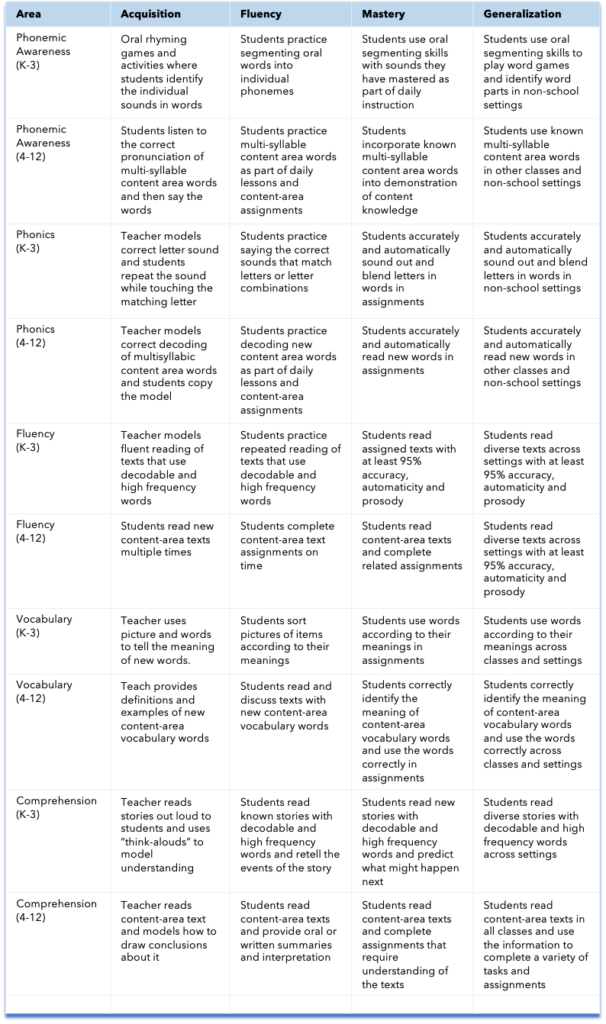December 17, 2020
A student’s ability to understand and make sense of the world around them is often directly related to their ability to read well.
The goal of reading instruction is to ensure students fully comprehend what they read and learn. This is why effective reading instruction must include two critical components: (a) reading content and skills, and (b) teaching practices that work for all learners.
This blog will review both of these components and explain how teachers can access additional information about reading instruction.
2 components of effective reading instruction
In 2018, a widely discussed podcast and article by Emily Hanford addressed the question, “Why aren’t kids being taught to read?” Hanford reviewed available research about effective reading instruction and then pointed out that such research—which is also known as the Science of Reading—is rarely covered in teacher education programs.
In 2000, the National Reading Panel (NRP) published findings from a comprehensive analysis of available research about the most effective reading instructional practices, which Hanford highlighted in her reporting. Let’s explore these findings in detail.
Component #1: Reading content and skills
The National Reading Panel report found that there are five essential components to reading and that all five need to be included in reading lessons across grades. The five areas are:
#1: Phonemic awareness
Phonemic awareness is the ability to hear and manipulate individual sounds in spoken words. It is essential for learning to read in the English alphabetic writing system and often overlaps with phonics instruction.
For example, a child must be able to hear that “noon” and “never” both start with the same sound. The child must also be able to blend the sounds /mmmmoooonnnn/ into “moon” to be able to connect sounds with written symbols.
For this reason, phonemic awareness is a strong predictor of a student’s early reading success.
#2: Phonics
Phonics refers to the knowledge of sounds that correspond to each letter or group of letters in the English alphabet.
Phonics is a system of teaching reading that builds on the alphabetic principle and is centered around the teaching of correspondences between letters or groups of letters and how they are pronounced.
Decoding involves learning how to convert printed words to spoken words. Decoding begins with using phonics skills to make letter/sound correspondences to know how to pronounce words and then attach meaning to them.
Phonemic awareness instruction improves a student’s phonics skills and vice versa.
#3: Fluency
Reading fluency is a combination of accuracy, automaticity, and prosody when reading so that the reader easily understands what is read. Reading fluency has four closely interrelated parts:
- Accuracy: Reading words correctly is a key component of fluency. Students must read words easily, without having to stop and decode them by breaking them into parts or sounding them out. The goal for fluency is that the student can read at least 98 out of 100 words easily and accurately.
- Speed: This does not mean students should read as fast as they can. While speed is important, it’s not considered fluent unless combined with accuracy, expression, and comprehension.
- Expression: The ability to read in a way that sounds like spoken language is called expression. When a student uses appropriate emotion, pauses for punctuation, and emphasizes important words, it shows that they understand what is being read.
- Comprehension: Being able to read words and understand what is being read is the goal of reading fluency.
#4: Vocabulary
Vocabulary refers to knowledge of the individual words used to communicate effectively when listening, speaking, reading, and writing.
Vocabulary plays a fundamental role in reading and is a main contributor to reading comprehension. Clearly, students cannot understand a text if they don’t know what most of the words mean.
Most vocabulary is learned indirectly, through everyday interactions with oral and written language. Other words are learned through direct instruction.
#5: Comprehension
Comprehension in reading is the understanding of the overall ideas and information contained in a text. To accurately understand written material, students must:
- Decode what they read.
- Make connections between what they’re reading and what they already know.
- Think deeply about what they’ve read.
Sufficient vocabulary is key to comprehension. Students who have strong comprehension can:
- Make connections about what they read
- Determine what’s important
- Know what the facts are
- Understand what may have caused an event to happen
- Identify which characters are good or bad
- Etc.

Incorporating reading and content skills into every class
It is important to note that all five areas need to be included in reading instruction every day at every grade level. This is because students will benefit from integrating their reading skills as they develop stronger proficiency.
Certainly, the instructional focus at the younger grades should include more emphasis on phonemic awareness and phonics. But young students also need to learn accurate and automatic decoding, word meanings, and how text conveys information.
In the higher grades, comprehension is the main focus, but older students still need to learn new vocabulary related to the content areas, develop fluency in reading new words, and learn how to decode multisyllabic content-area words, especially those with Greek and Latin roots and affixes.
In order to learn such words, phonemic awareness skills take on new importance because the sounds are important for decoding and fluency. When students lack strong instruction in one or more of the skill areas, deficits can impact student learning across content areas.
Creating successful readers
Discover pre-K‒grade 12 solutions from Renaissance to support your students’ literacy development.
Component #2: Reading instruction practices
Along with reading content and skills, the methods used to provide reading instruction are also very important to students’ success.
There are two instructional details that have been found to be the most effective across students. Reading instruction that is both direct and systematic has been found to be the most beneficial for learners of all ages.
Direct instruction
Direct instruction refers to teaching methods that provide learners with precise details about the skills to be learned, along with many opportunities to practice those skills. In fact, direct instruction methods use an instructional hierarchy of specific learning stages that provide learners with:
- Opportunities to see examples of the skills.
- Guided practice using the skills.
- Independent practice until the skills are mastered.
Direct instruction (DI) methods were pioneered by Siegfried Engelmann and his colleagues in the 1960s. Engelmann and his colleagues published curricula that incorporate these methods, and they are often referred to as “big” DI to acknowledge the connection to these authors.
It is possible to use direct instruction methods as part of any classroom reading instruction, and such practices are often known as “little” DI (or “di”) because they incorporate the methods but are not necessarily published or under copyright.
Instructional hierarchy
Direct instruction works because it includes activities that follow the instructional hierarchy (Loring et al., 1978). This hierarchy includes four stages that reflect the learning process. The four stages are:
- Acquisition: The learner has no background with the skill or knowledge to be learned. The teacher describes and models the skill or knowledge and then provides students with scaffolded practice that focuses on accuracy.
- Fluency: The learner practices the skill or knowledge regularly in order to use it automatically.
- Mastery: The learner uses the knowledge or skill spontaneously during school-based activities.
- Generalization: The learner uses the knowledge or skill spontaneously in settings and situations different from where it was learned (e.g., another course or outside of school).
Direct instruction is an important component of effective reading lessons because it provides opportunities for learners to access reading instruction regardless of prior knowledge or experiences.
The following table provides examples of instructional activities for all five areas of reading at each stage of the instructional hierarchy. There are two examples for each area and stage: one reflects instruction for students in kindergarten through grade 3, and the other reflects instruction for students in grades 4 and higher.
Systematic instruction
Another important teaching practice for reading instruction is for it to be systematic. Systematic instruction involves providing lessons in a very specific sequence. In the case of reading, systematic instruction provides a coherent order to the lessons so that new learning builds on prior learning.
Usually, easier skills are taught before harder skills. Systematic reading instruction includes practices such as teaching the most frequent letter sounds first and separating presentations of highly similar letters and sounds so that students do not get confused.
This type of instruction allows students to keep practicing beginning skills as they add new skills over time.
How learner differences affect student outcomes in reading instruction
Although direct and systematic instruction that includes all of the 5 “big” areas of reading benefits all students, the exact duration and frequency of lessons necessary are likely to vary across students. Some students will reach the mastery and generalization stages very quickly, while others will need many more opportunities to practice during the acquisition and fluency stages.
Providing differentiated reading instruction for all students involves arranging daily schedules so that all students participate in a high-quality core program, and there are supplemental lessons that provide reteaching and repetition of lessons for those students who need them.
Reading is not a natural, innate skill. Instead, it must be learned. A strong body of research confirms that direct and systematic instruction that includes all five of the “big” areas of reading is effective for all students. However, not all teachers learned about such methods during their preparation in college.
There are many resources for teachers who need to learn more about effective reading instruction methods, including the well-known Reading Rockets website. Renaissance can also assist you with valid and reliable reading assessments, a unique phonics screener, and literacy practice and instructional programs for early readers through high school students.
Connect with an expert today to learn more.


